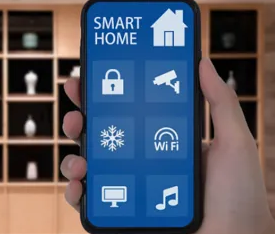If you’re like most people, you probably have a pretty cluttered house. You’ve got all your regular household items in one place, plus a few things that your parents left behind when they moved out. And because you’re not really sure what to do with all that extra space, you end up stacking more and more furniture until the living room starts to feel like a storage locker.
Luckily, there are ways to declutter your home without having to spend hours on the chore list. Check out these five download mp3 conconventer youtube that can help make your life a little easier.
How smart home products work
Smart home products are designed to make your life easier by automating certain tasks. Many of these products connect to the internet and can be controlled through an app or a remote control.
Here are a few examples of smart home products that you might be interested in:
1. A smart thermostat can automatically adjust your temperature depending on the weather outside.
2. A smart smoke detector can alert you if there is smoke in the vicinity.
3. A smart security system can monitor your property for intruders and send alerts if something is detected.
The different types of smart home products
There are a few different types of smart home products, and each offers its own set of benefits and drawbacks. Some products are more specific to one type of home automation, while others can be used for a variety of tasks.
One popular type of product is the smart home hub. These devices include a variety of sensors that can detect and respond to various events in your home, such as when you open a door or turn on a light. Smart hubs can also connect to other devices in your home, such as your television or security system, to make your life easier.
Another popular type of product is the Nest Learning Thermostat. This device allows you to control your temperature using just a few simple commands, rather than having to fumble through complicated settings on your thermostat. The Nest also monitors your energy use and warns you if you’re about to hit your monthly budget limit.
Smart lights are another common type of smart home product. These bulbs can be controlled using apps on your smartphone or computer, allowing you to adjust the light level without ever having to leave your bed or chair. LED lights are typically considered more energy-efficient than traditional incandescent bulbs, so they’re a good
What is the best way to use smart home products?
There are many different ways to use smart home products. One way is to use them to control your lights, thermostat, and other items in your home. You can also use them to keep an eye on your home while you’re away.
What are the benefits of a smart home?
Benefits of a smart home can be categorized into three areas: security, convenience, and energy efficiency.
When it comes to security, a smart home can help you monitor and manage your family’s activities more efficiently. For example, if you have a smart TV that can be used as a home security camera, you can watch footage of your property while you are away, and receive notifications if anything happens.
Convenience is another big benefit of a smart home. For example, if you have a smart thermostat that connects to your smartphone to control your heating and cooling systems, you can save money on your energy bills by being more aware of when the temperature in your home is getting too high or low. Additionally, you can use smart home technology to automate tasks such as turning on the lights when you enter your home or activate the security system.
Finally, smart homes can also help reduce your carbon footprint. For example, if you have an electric car that plugs into the grid through a charging station, you could use the same charging station to power your home appliances. By doing so, you would not need to install additional electrical infrastructure in your home and would therefore reduce the amount of carbon emissions that are
What are the different types of smart home products?
Smart home products come in a variety of shapes and sizes, and can do a range of different things. In this article, we will discuss the different types of smart home products, and what they are used for.
There are three main types of smart home products: traditional smart home products, voice-activated smart home products, and connected device platforms. Traditional smart home products include devices like light bulbs, thermostats, and security cameras. These devices connect to the internet and other devices in your home to control their functions or communicate with other devices.
Voice-activated smart home products allow you to control your devices using voice commands. For example, you can say “turn on the lights” to turn on all the lights in your house, or “lock the door” to lock your door. These products also often have features that allow you to control other devices in your house using voice commands, such as music playback and turning on the TV.
Connected device platforms are a type of traditional smart home product that connects various devices in your house together. This way, you can use one app to control all of your devices. Some popular connected device platforms include Amazon
What are the different types of smart home systems?
There are many types of smart home systems, each with its own advantages and drawbacks. Here are the most common types:
-Wireless smart home systems: These systems use wireless technology to connect devices in your home wirelessly. They’re generally more reliable than traditional wired systems, but they can be less expensive and easier to set up. Some wireless smart home systems also allow you to control devices outside your home through an app or website.
-Home automation systems: Home automation systems allow you to control various aspects of your home using software or hardware. These systems typically include sensors that monitor things like temperature, humidity, and motion, giving you automated responses for things like turning on lights or adjusting the thermostat. They can be more expensive than wireless smart home systems, but they’re often easier to use and configure.
-Central hub/single point of control: Central hub/single point of control systems work similar to home automation systems, but they allow you to control more devices from one place. They often include a built-in touchscreen display and more advanced features like voice recognition and remote access. These systems can be more expensive than other types of smart home systems, but they offer greater flexibility and convenience.”
How do smart home products work?
Smart home products work by connecting to your home’s existing wiring and sensors to allow you to control various devices in your home using your smartphone or computer. Some of the most common smart home products include smart locks, lights, thermostats, and security systems.
What are the major components of a smart home system?
The components of a typical smart home system are:
-A router or hub to connect the devices in the system
-A computing device, such as a computer or a tablet, to control and monitor the system
-An app to manage the system
-A sensor to detect changes in the environment and trigger actions on behalf of the system, such as turning on lights or sending alerts
-An actuator to activate devices or change settings
What are some of the challenges associated with implementing a smart home system?
One of the challenges with implementing a smart home system is that it can be difficult to find the right devices and products to fit your specific needs. Additionally, some people may be intimidated by the prospect of installing new technology in their homes. If you’re considering implementing a smart home system, here are a few tips to help you get started:
1. Consider your goals. Before you buy any devices or start installing smart home software, make sure you have a clear idea of what you want the system to do. Do you want to manage your lights and appliances from one central location? Control your thermostat using your phone? Enable automatic locking when you leave the house? Once you know what you need, start researching which products are compatible with your goals and preferences.
2. Familiarize yourself with the different types of devices available. There are a variety of different types of devices available for smart home systems, including smart switches, sensors, and hubs. It can be helpful to read reviews and compare prices before making a purchase.
3. Install simple components first. If you’re not sure whether or not a particular smart home product is right for you, start by installing simple components such as smart switches and sensors
FAQ About smart home products
How do I make my own smart home products?
First off, start by deciding what you want to make. There are whole range of smart home products and ideas from smart light bulbs, to a whole home security system. As for content, it can be anything from a story about the invention of your product to instructions on how to make. Remember that the ideas behind your product don’t have to only come from you.
How many smart home products do they offer?
Pendant que nous vérifions la commande, nous allons le confirmer dans les étapes suivantes. Une fois il est confirmé, nous vous ferons parvenir un compte rendu à l’adresse e-mail Vos commandes avec des photos ou une preuve de vente d’expédition de la livraison. Si ce n’est pas le cas, veuillez contacter notre service clientèle pour plus d’informations.
My house is falling apart and I’m looking for tutorials on how to fix it.
If you’re looking for video tutorials on how to fix your house, there are many different ways to find a tutorial online. Places like Youtube and Dailymotion might be useful for finding some great tutorials, or you can directly look for more detailed instructions in the tutorial section of our website. Our tips from a professional DIYer also have some great tricks that will help you fix your home.
Can you make a Smart Home product?
Smart home products vary by what you are making. There are smart devices that can be made with a microcontroller and then there are virtual assistants that need Google Home or Alexa. Smart home products can use any or all of the following: Arduino, Raspberry Pi, Intel Edison, ESP8266, Sonoff Basic/Wemos D1 Mini/Wemos D1 Mini Datasheet
Is there a difference between smart home products?
The world of smart home is composed of many different technologies- most of which are still in research and development. “Smart home” refers to any home that is networked. Technologically speaking, there’s not many difference between a regular house and a smart one. However, what makes a smart home different from regular houses is the inclusive nature of these products and their connectivity with others. Smart home devices currently being integrated into your homes can also make you safer or healthier.
What are the advantages of using a smart home product?
Smart home products are an innovative way to keep your home safe and smart. They make the connections between the internet and your house easier than ever before. In fact, our product is compatible with Amazon Alexa’s smart assistant as well as Google Assistant. It’s also completely wireless so that you can control it from anywhere using a cellphone or tablet.
How much does it cost to work with smart home products?
Smart Home products have a wide range of prices and tariffs. You can view the tariffs we offer for each Smart Home product on our website and you can apply the tariff near where you live. Alternatively, you can email or call to ask for a quote if you want more information on this facet.
Do these smart home products work with Alexa?
We have a few products that work with Alexa and we’ve included those specs in the product description for each. We do not believe that it is an unreasonable standard for a smart home to include voice control, but if you are looking for specific features that only work with Alexa you can use our comparison tool to see what those features from specific brands cost.
Pros of smart home products
• Automation: With smart home products, you can automate your home to make it easier and more convenient for you.
• Security: Some smart home products can help you keep your home safe and secure.
• Connectivity: Many smart home products are compatible with other devices and platforms, making them easy to connect and use.
• Customization: You can customize your smart home products to make them the perfect fit for your needs.
• Price: Some smart home products are relatively affordable, making them a good value for money.



